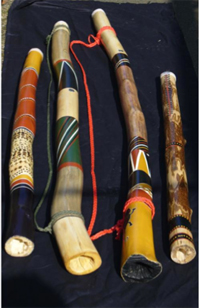Noises of a Didgeridoo Maker

For many years now, I have been making Didgeridoos. It all started with a friend of mine, who taught me how to make them. Sadly, he has now passed away, but he has left his legacy with me. As a hedge-layer, I can gather an abundance of woody material, collecting them from path clearance work, coppicing and other woodland management tasks. I try to ensure that I keep as environmentally friendly as possible by only taking sticks that are going to be cut out anyway.
The development of the Didgeridoo
After learning how to make them in one particular way, I went on to research how they were traditionally made. There is a process found in parts of Australia, where termites naturally eat the centre wood from a variety of the Eucalyptus trees. Termites require a constant temperature and therefore only eat out to a certain depth of the tree, leaving the outside intact - as it is too warm for them to continue. Due to a lack of termites in this country, I have developed my own technique!
 Although my methods are a closely kept secret, I can explain the general process.
Although my methods are a closely kept secret, I can explain the general process.
Firstly selecting the 'stick'. Generally, I look for nice shapes, for example, fairly straight sticks with a wide bottom and a narrow top. Although this is ideal, it is not always necessary. Ash trees seem to be the most versatile in this respect, but I am always looking for a variety of different types of wood. Once harvested, I allow the sticks to dry naturally and then prepare them by removing the bark. After the bark is removed, this gives me an idea of any knotty and problem areas to watch out for.
Next the stick is split in half, I usually use a froe for this. This is a traditional tool formed of a long strong blade that is sharpened on one side and has a stick handle at one end. It allows you to tap into the top of a long stick and use the handle to lever the stick in half. I use this because I prefer traditional methods over modern but, on occasion, I have used a band-saw.
Once the stick is split, it is simply a case of hollowing out the two sides, and gluing back together. This is where the secret lies as it is all about the shaping of the inside to get it to play. Once glued, it is sanded, tuned and then painted.
Every Didgeridoo that I make is unique; I like to put in personal touches about the person I am making it for to make it completely one-of-a-kind. My painting ranges from traditional aboriginal patterns, to more individual decorations such as a recent design of a horse for a lady, who has just bought one.
I attend craft shows, woodland fares and I am available for didgeridoo making courses. Also, all of my work is available to buy. Hopefully, I will have a website up and running soon, but until then please contact me if you are interested. My email is : [email protected].
Comments are closed for this post.


Hi,we run a small but very exiting world music festival in hay on wye Wales and whilst searching the internet found you and thought you were the perfect people to meet people like us !!
Visit http://www.elementarydidgeridoofestival.co.uk
Check out the performer line-up we have secured so far on our “What’s on” pages.
Loads of UK and global acts which we feel make a knock-out line up to end all line ups (well, until next year anyway ;>))
Tickets on sale NOW @ http://www.elementarydidgeridoofestival.co.uk/tickets
– Elementary Didgeridoo Festival
elementary didgeridoo
ELEMENTARYDIDGERIDOOFESTIVAL.CO.UK
paul cook
27 April, 2015